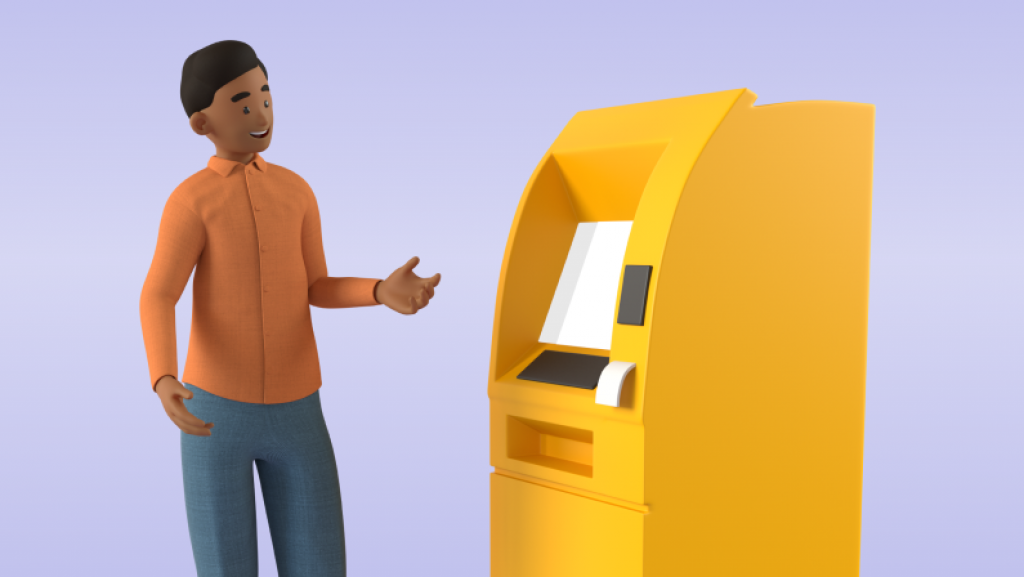Universal design of self-service machines
When you buy or lease a self-service machine, you want as many people as possible to be able to use it. This is the case whether it is a payment terminal, a vending machine, or a ticket machine. The design and placement of the self-service machines must take account of the fact that users have different abilities and needs.

What is a self-service machine?
A self-service machine facilitates self-service. The regulations define a self-service machine as follows:
Self-service machine: A machine or other device exclusively operated by the user in
order to purchase a product or for the execution of a service.
There are self-service machines for many different purposes. Examples of self-service machine include:
- Payment terminals
- ATMs and deposit machines
- Vending machines
- Ticket machines
- Queuing systems
- Check-in terminals
Self-service machines - accessibility for everyone (2 minutes)
Why should self-service machines be universally designed?
The purpose of self-service machines is to ensure that those who use them can be served quickly and efficiently without assistance. Universal design is intended to ensure that no one is unable to use such solutions. Besides, more people being able to use their services is of benefit to organisations.
Vision, hearing, physical size, mobility, and cognitive abilities vary from person to person. The design and placement of the self-service machine must take account of this. For example, someone with poor vision will need large, clear writing, good contrast, and an operating panel/screen with good lighting conditions and no glare or reflections. Someone who is severely visually impaired or blind will need tactile labels and the option of audio feedback. Some users have problems reaching up to self-service machines because they have been placed too high up. Other users may be pushing a buggy or sitting in a wheelchair and unable reach the self-service machine.
If your organisation uses a self-service machine, you must make sure that you order one that takes these variations into account and satisfies the universal design requirements. You must also ensure that the self-service machine is suitably located so that it is easy to find and everyone can use it.
Requirements for self-service machines
The standards the regulations refer to are starting to show their age. This means that they set few requirements for newer functions in self-service machines, such as touchscreens.
The Authority is working on updated regulations for the universal design of self-service machines. Work on the regulations will proceed in parallel with the EU’s European Accessibility Act (EAA) being enacted in Norwegian law by the end of June 2022 (in Norwegian).
EN 301 549:2019 Accessibility requirements for ICT products and services (etsi.org, external page) is expected to become a harmonised standard for the European Accessibility Act.
The Authority recommends that organisations planning to develop or introduce new self-service machines should follow the requirements in EN 301 549:2019, even though these are not currently statutory requirements.
The current regulations refer to the following standards:
- CEN/TS 15291:2006 (Standards Norway, external page) - Identification Card Systems - Guidance on design for accessible card-activated devices.
- NS-EN 1332-1:2009 (Standards Norway, external page) - Identification Card Systems - Human-machine interface - Part 1: Design principles for the user interface.
- NS-EN 1332-2:1998 (Standards Norway, external page) - Identification Card Systems - Man-machine interface - Part 2: Dimensions and location of a tactile identifier for ID-1 cards.
- NS-EN 1332-3:2008 (Standards Norway, external page) - Identification Card Systems - Man-machine interface - Part 3: Keypads (Withdrawn, replaced by NS-EN 1332-3:2020 (Standards Norway – external page)).
- NS-EN 1332-4:2007 (Standards Norway, external page) - Identification Card Systems - Man-machine interface - Part 4: Coding of user requirements for people with special needs.
- NS-EN 1332-5:2006 (Standards Norway, external page) - Identification Card Systems - Man-machine interface - Part 5: Raised tactile symbols for differentiation of application on ID-1 cards.
- NS-EN ISO 9241-20:2009 (Standards Norway, external page) - Ergonomics of human-system interaction - Part 20: Accessibility guidelines for information/communication technology (ICT) equipment and services (ISO 9241-20:2008 (Withdrawn, replaced by NS-EN ISO 9241-20:2021 (Standard Norway, external page)).
- ISO 20282-1:2006 (Standards Norway, external page) - Ease of operation of everyday products -- Part 1: Design requirements for context of use and user characteristics.
- ISO/TS 20282-2:2006 (Standards Norway, external page) - Ease of operation of everyday products -- Part 2: Test method for walk-up-and-use product (Withdrawn, replaced by ISO/TS 20282-2:2013 (Standards Norway, external page)).
- ISO/TR 22411:2008 (Standards Norway, external page) - Ergonomics data and guidelines for the application of ISO/IEC Guide 71 to products and services to address the needs of older persons and persons with disabilities (Withdrawn, replaced by ISO/TR 22411:2021 (Standards Norway, external page)).
